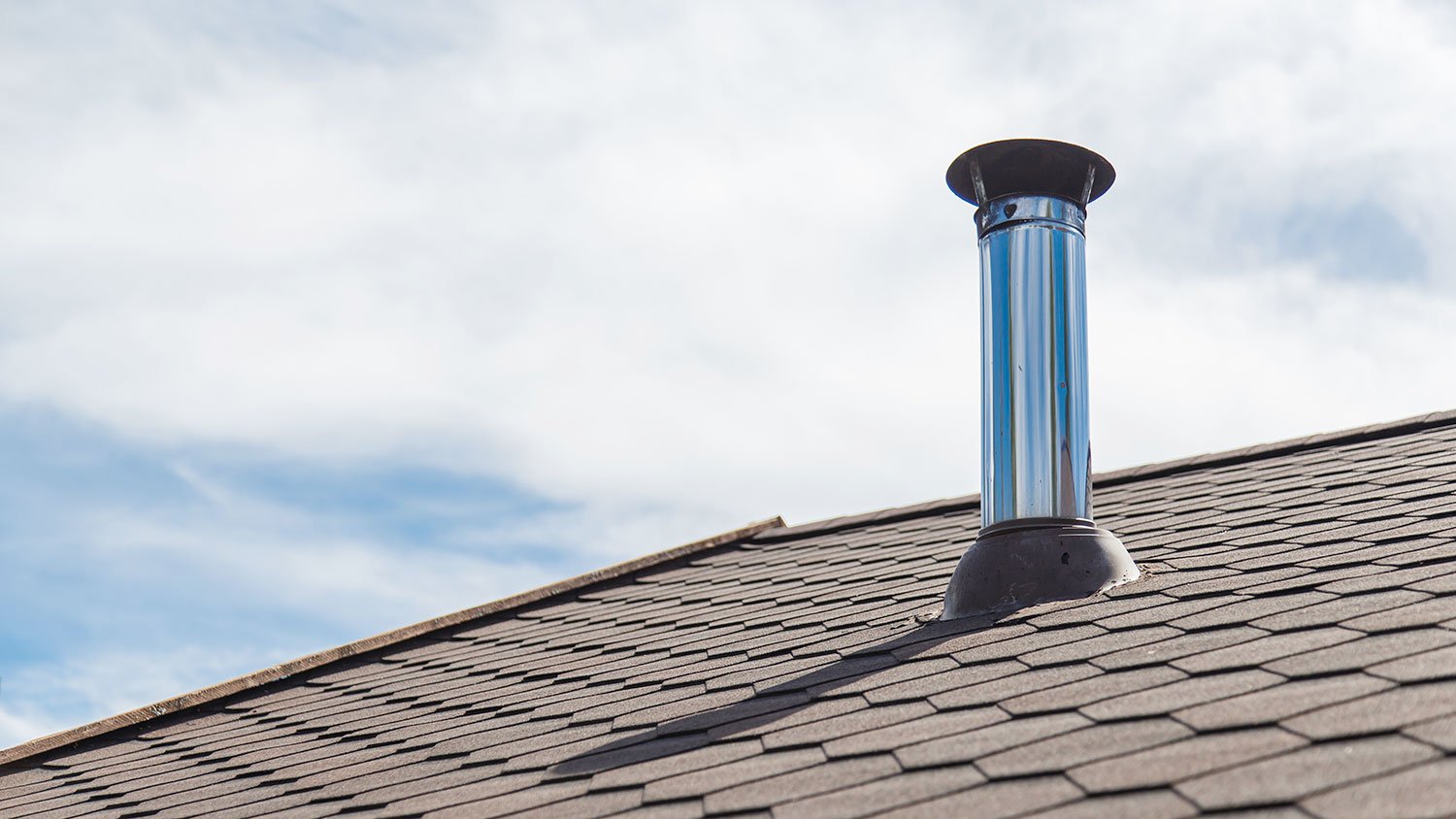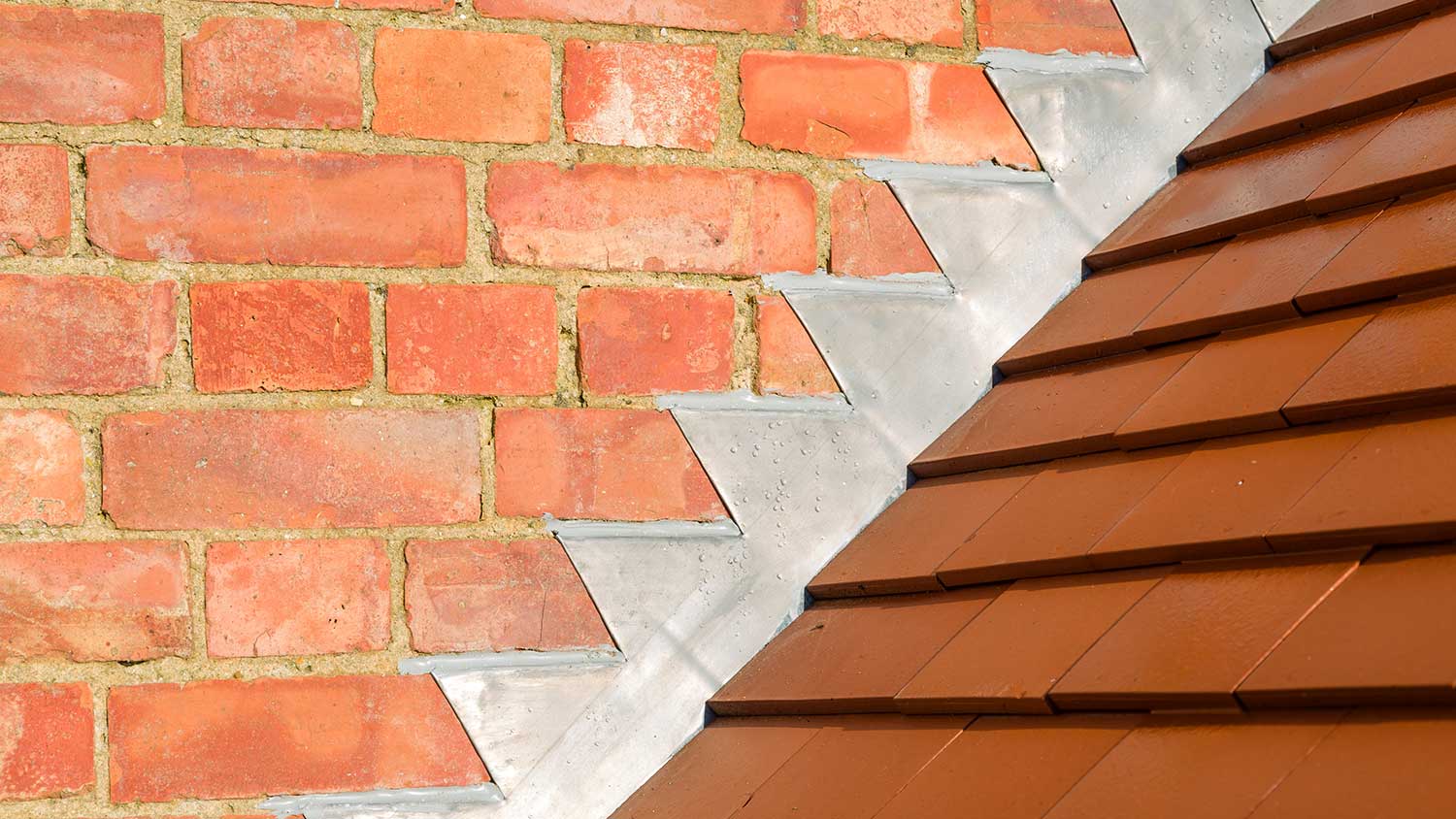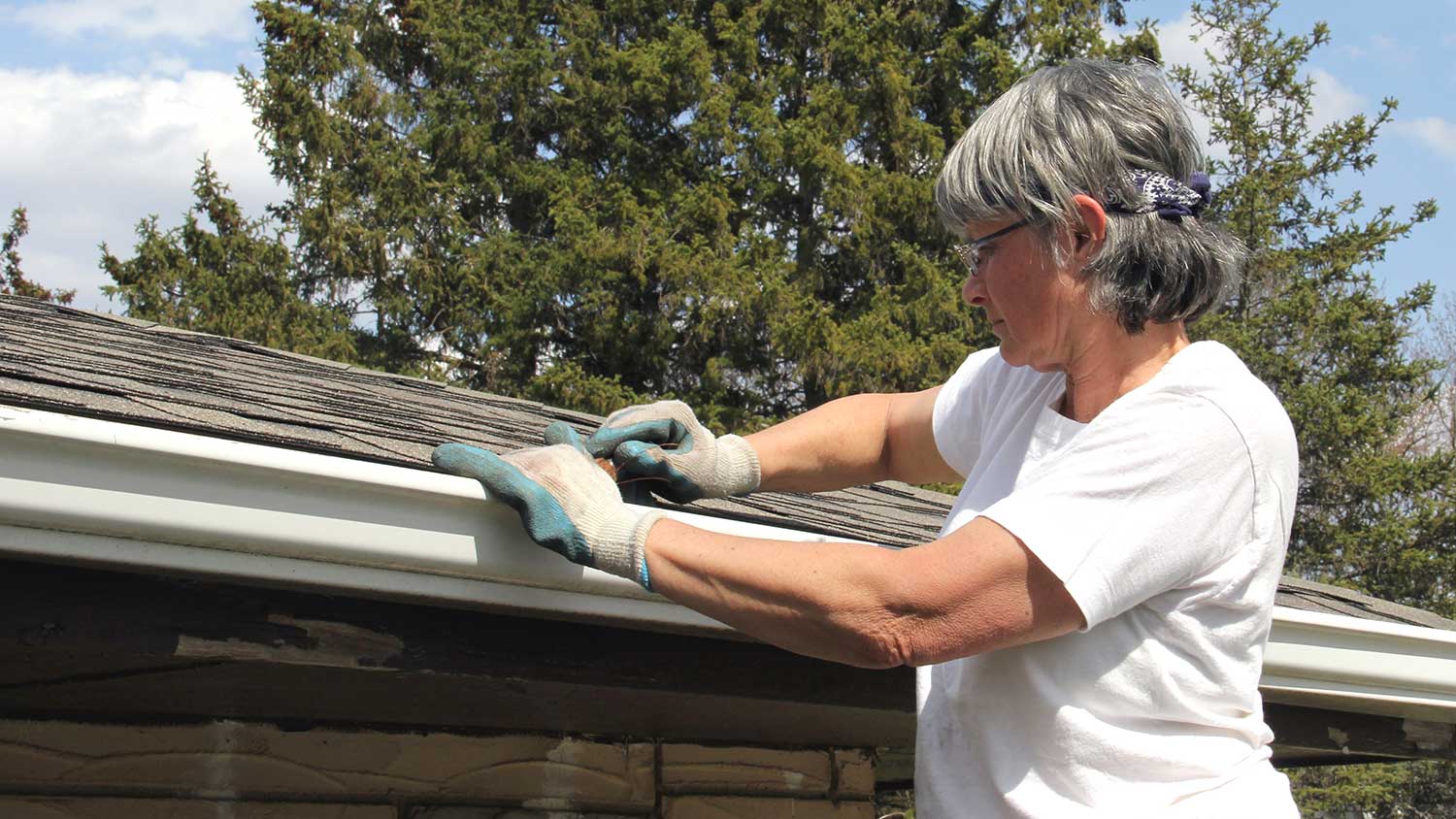Your roof is one of your home’s most important lines of defense against the elements. A roof leak can become a big problem if not dealt with quickly. In some cases, small leaks can be fixed relatively simply using only a few tools and supplies from your local home center. Use this helpful guide on how to fix a leaking roof to identify and fix common leaks on your own.
Why Is It Important to Fix a Leaking Roof?
A leaking roof is a problem you should address immediately. Even if the problem seems minor or you’re planning on replacing the roof in the next year or so, letting a small leak go can cause big problems that extend beyond your roof. Water penetration can cause your home’s framing and sheathing to rot, destroy your insulation or ceilings, and lead to mold.
How Much Does It Cost to Fix a Leaking Roof?
The cost to repair a roof that is leaking can range from about $10 to $120 if you do it yourself. The final DIY repair price depends on the extent of the damage and the type of roof material you have. If you choose to hire a local roof repair company for the job, expect to pay anywhere from $360 to $1,550 on average.
How to Prep for Fixing a Leaky Roof
Roofing repairs can be dangerous. Avoid falls by wearing soft-soled boots and working on a clean, dry roof. Check the immediate forecast in your area and plan to work on your leaky roof during the driest, warmest stretch of days. DIY roofing work should mainly be done in late spring, summer, or early fall to minimize your roof deck’s potential exposure to moisture.
You should always have an assistant nearby to hold your ladder and keep an eye out in case anything goes wrong. Qualified roofing pros always come equipped with a fall restraint system to slow or stop them from falling off of roofs, which can be expensive and require specific training to use properly.
How to Identify a Roof Leak
Finding the source of a roof leak often takes more time than fixing it. Luckily, there are some easy tips you can use to make the task easier. Follow the tips below, but be patient and expect the process to take an hour or more.
- Look for evidence in your attic. If your home has an attic or crawlspace, use a flashlight to search for water stains that you can trace up to the roof or rafters.
- Move from low to high. Start from the bottom of a stain and trace the leak upwards. You may see black or white coloration, mold, or mildew at the location of the leak.
- Soak the roof. With a helper watching in your attic, climb on the roof and use a hose to heavily soak very specific sections for several minutes each until your helper sees water.
- Check for damage around projections or penetrations. Leaks often form near openings in the roof such as vents, dormers, attic fans, pipes, and chimneys.
- Scan larger areas. Signs of a leak may form several feet from the actual leak itself. Look above stains or to the left and right to pinpoint the source.
Related Article
What to Do If Your New Roof Is Leaking
Leaks in your new roof are typically covered by a warranty
How to Fix a Leaking Roof
Because leaks can form in so many different areas of your roof, there is no one method to fix a leaking roof. Once you’ve identified the source of your leak, use the approach below that best suits your situation. Most of these approaches are simple and won’t take much time.
Replace Vent Boots or Fasteners

Photo: vladdeep / Adobe Stock
Many roofs have vertical pipes called vent stacks that connect to plumbing fixtures in your home and release pressure from your plumbing system. These vents often have a base, or boot, made of plastic, metal, or flexible rubber. Cracks, tears, rot, or broken seams in a vent boot can all cause roof leaks. Also, many boots have exposed nails on them that should be covered with sealant to prevent oxidation of the fasteners. If a nail starts to rust out, it can result in a leak that is relatively easy to fix—if the nail is secure into the sheathing, simply place sealant on the head of the fastener to stop the leak.
Sealant breaks down under UV light and needs to be checked and possibly reapplied every three to five years as a general roof maintenance item.
If you notice vent boot problems, grab a helper and follow these steps:
- Purchase a new vent boot to replace the existing one.
- From your rooftop, use a pry bar to pull out the nails holding the shingles to the boot.
- Pry back the shingles without removing them. Have your helper hold them, if needed.
- Remove the nails that hold the vent to the roof deck and remove the vent.
- Apply a thick bead of roofing cement or sealant to the bottom of the vent’s flashing.
- Have your helper gently roll back the shingles so you can slide the new boot in place. Make sure that the shingles go back in the same way they were—the top of the boot and the sides should be under the shingles so that water cannot get under the boot as it flows down the roof.
- Attach the new boot at all corners and every 4 inches with washer-head roofing screws.
- Cover the new nails with cement or sealant.
- Nail down the shingles you pulled back.
If your existing boot is in good condition but you notice that some of the fasteners are missing, you can simply replace them with your washer-head screws.
Cover Old Mounting Holes
Your roof may have tiny holes left behind from old vents, satellite dish or antenna mounting brackets, or some other previous attachment. To patch these holes and prevent water from getting through, take the following steps:
- Pull out any misplaced roofing repair nails.
- Slip a piece of roof flashing underneath the shingle where the hole is located.
- Secure the flashing with a bead of caulk or roof cement on the top and bottom edge.
Fix Step Flashing

Photo: Paul Maguire / Adobe Stock
You’ll find short sections of overlapping L-shaped flashing around your chimney or on walls that intersect with your shingle roof. These pieces of flashing are meant to direct water over the shingles directly downhill from them, but when they rust or come loose they can let water underneath the shingles instead. To replace a rusted piece of flashing, take these steps:
- Carefully loosen the shingles near the flashing with your pry bar.
- Remove the old flashing and push a new piece in its place.
- Secure the new flashing with roofing cement.
- Nail the flashing and shingles back into place.
If you have a rock or brick wall, the flashing needs to go into the wall (this is called “counter flashing”) and have sealant placed at the seam as a secondary line of defense. With wood or cement board siding, the flashing needs to go behind the siding.
Fix Cracked Dormers and Walls
Cracks between siding or between corner boards and windows can both be entry points for water. If you have dormer walls with cracks from old or missing caulk, fix them with the following steps:
- Use a putty knife to dig out cracked or dry caulking that isn’t providing a proper seal.
- Apply a new layer of high-quality caulk to the affected areas, including at corner flashing.
- Check the siding directly above your step flashing for cracks or rotted areas.
- Replace missing or damaged siding with a piece that overlaps the flashing by 2 inches.
Patch the Roof Deck
A roof’s plywood decking, or sheathing, may develop water damage, mold, or mildew on its underside. If your shingle roof is leaking due to roof deck damage, follow these steps to remove the shingles and patch the problem area with a piece of replacement plywood or OSB.
- Start two rows of shingles above the damage. From the bottom of the shingles, pry nails loose and pull the shingles away to expose the roofing paper or underlayment below.
- Work downwards through rows to remove all shingles from the damaged area.
- Slice off the roofing paper or underlayment with a utility knife.
- With the damage exposed, snap chalk lines down the center of the rafters to the left and right, above, and below.
- Set your circular saw’s blade depth to the thickness of the roofing deck plus 1/16th-inch.
- Kneel outside the marked section and saw along the chalk lines to cut out the damage.
- Pry nails from the section you just cut and remove the damaged plywood.
- Use the damaged section as a template to mark the dimensions of your plywood patch.
- Set the patch in place and nail it onto the rafters with 8d common nails.
- From the bottom up, nail down new roofing paper or underlayment using roofing nails, overlapping each row by 4 inches.
- Lay your first row of new shingles left to right along the bottom, leafing new shingles into existing ones as needed.
- Nail down the new shingles along the top of the row.
- Continue laying and nailing down new rows until you reach the top row. Slide the new shingles under the top row.
Replace a Flat Roof Membrane
If you have a flat roof, DIY repairs can be as simple as removing and replacing the surface membrane. Follow these steps to get the job done:
- Measure your roof’s dimensions and purchase an ethylene propylene diene monomer (EPDM) membrane to fit. Your supplier can cut it to size for you in-store.
- If needed, remove your gutters and fascia to access the roofing underneath.
- Remove the plies of the roof by driving a spade into the surface and under the plies. Take care not to stand on sagging spots.
- Remove the framework around the roof’s perimeter by hand after jostling it loose.
- If any perimeter pieces remain stuck to the surface, scrape them off with a scraper.
- Remove the remaining plies of felt from around the roof perimeter.
- If your roof has timber fillets, slowly pry and pop them off with your spade or pry bar.
- Make sure your roof surface is clean and dry and the outdoor temperature is above 50 degrees Fahrenheit before you lay the EPDM.
- With your EPDM folded, lay it in the center of your roof so its top and bottom edges are parallel with the top and bottom edges of your roof.
- Drag the right corners of the EPDM to align them with the right edge of the roof.
- Drag the remaining corners of the EPDM to align them with the left edge of the roof. Let the new membrane rest for 30 minutes.
- Draw the left edge of the membrane back and fold it to the right edge so there are two equal layers on the right half of your roof.
- Use an adhesive roller to apply an opaque layer of water-based adhesive on the now-exposed half of the roof. You should not be able to see the roof under the adhesive.
- Gently roll the membrane back in place on the left side of the roof while the adhesive is still wet. Roll until you reach the edge.
- Press the membrane in place with a broom, working out from the center crease to remove air pockets. Wait 30 minutes for it to dry.
- Repeat steps 12 through 15 with the other half of your roof.
- If you removed your gutters, fascia, or fillets, put them back in place.
Got a leaky winter roof? “Snow” problem! Here are some prevention tips
Taking Care of Your Roof to Prevent Leaking

Photo: Dave Willman / Adobe Stock
Roof leaks are not only hard to detect, but they’re often too severe to prevent by the time you notice signs of damage. Proper roof care is key to preventing that damage in the first place. Use the following tips to take care of your roof and keep damage at bay.
- Have your roof inspected regularly. Roof leaks are rarely obvious. Have a professional roof inspection once a year to catch problems that you might miss on your own.
- Clear your attic ventilation. Blockages in attic ventilation can lead to moisture and heat buildup that can soak your insulation and lead to rot in your roof’s structure. Oftentimes, soffit vents are blocked with insulation by the installers, which prevents proper air flow.
- Watch for damage in drip edges. Your roof’s drip edge keeps water off the roof. Gaps can lead to damage and create entry points for insects and other pests.
- Maintain your gutters. Clogged gutters can cause water to pool on your roof. Whether you clean them out yourself or hire a pro, make sure to keep your gutters clear.
- Trim your trees. Plants that grow too close to your roof can create damp, shaded areas and pose a hazard during heavy storms. Keep branches trimmed back from your home. Generally, all branches should be at least three feet away from the roof.
- Check fasteners: Check that any exposed fasteners are covered with sealant to prevent oxidation of the fasteners.
Should I Replace My Leaking Roof?
The life span of a roof depends on the roofing material and the maintenance it has received. So while repairing a leaking roof should be done as soon as possible, deciding whether or not you should replace your roof may require more consideration.
Signs you should opt for roof replacement rather than repair include:
- Sagging areas
- Large areas of missing or cracked roof shingles or tiles
- Multiple leaks in different places
- Extensive storm damage
Also take into account whether your roof is close to the end of its estimated life span, which will depend on the roofing material:
- Asphalt roof: 12–20 years
- Metal roof: 40–70
- Slate: 50 years
- Composite: 50 years
DIY vs. Hire a Pro
Though roofing repair can be dangerous to do yourself, it is possible and can save you a significant amount of money if you have the experience. Repairing a leaky roof as a DIY project can cost you anywhere from about $10 to repair a simple cracked vent booting or reseal a joint, all the way up to $120 or more to mitigate ice buildup.
For most homeowners, however, it’s best to hire a roofing pro to diagnose and repair any damage to your roof. This is especially true if the leak involves flashing. A roof’s many components need to be properly aligned to effectively protect your home, and the work involves climbing on your roof which can pose a risk to your safety. Professional leak repairs cost an average of $360 to $1,550 depending on the type of damage.
Many roofing contractors have a minimum charge; it’s good to find out what it is before you hire them. Also, ask if they offer a warranty for their repair work. If they are unsuccessful finding a leak on their first attempt, it’s good to know how they’d handle that situation.









